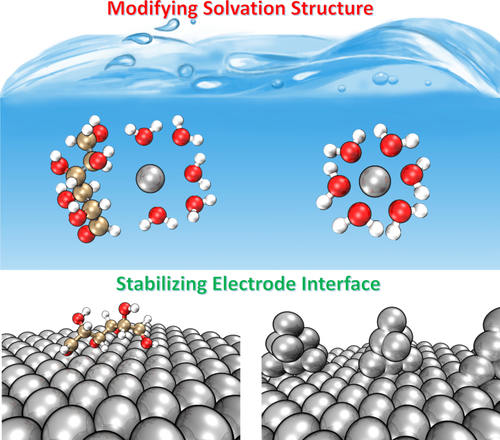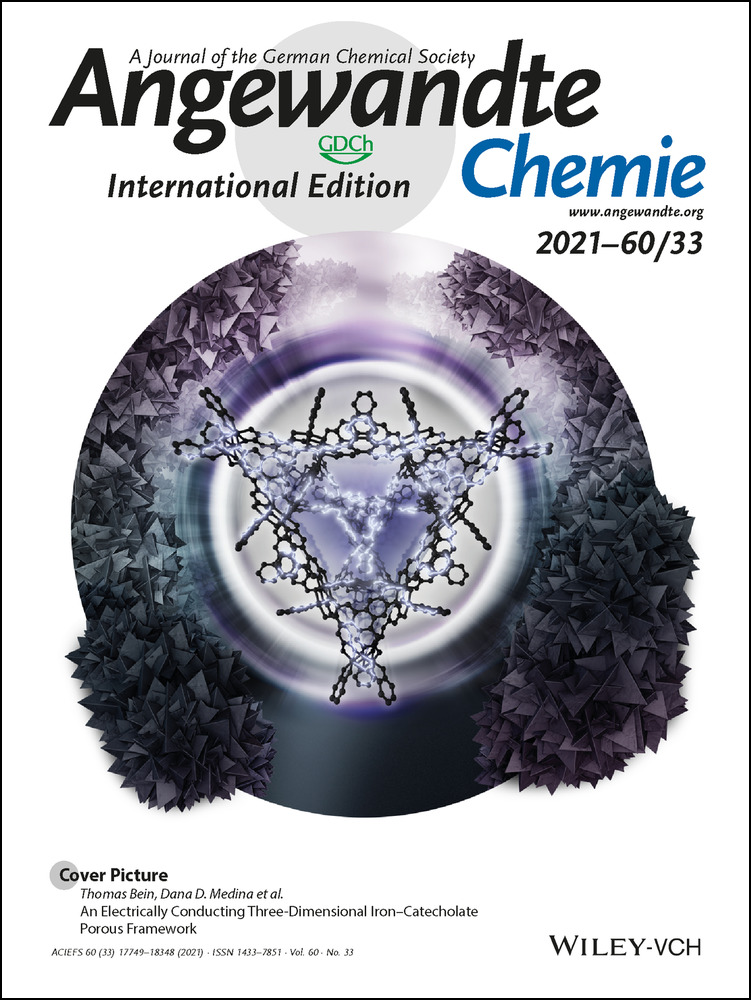Simultaneous Regulation on Solvation Shell and Electrode Interface for Dendrite-Free Zn Ion Batteries Achieved by a Low-Cost Glucose Additive
Dr. Peng Sun
Siyuan Laboratory, Guangdong Provincial Engineering Technology Research Center of Vacuum Coating Technologies and New Energy Materials, Guangzhou Key Laboratory of Vacuum Coating Technologies and New Energy Materials, Department of Physics, Jinan University, Guangzhou, Guangdong, 510632 P. R. China
Search for more papers by this authorDr. Liang Ma
Siyuan Laboratory, Guangdong Provincial Engineering Technology Research Center of Vacuum Coating Technologies and New Energy Materials, Guangzhou Key Laboratory of Vacuum Coating Technologies and New Energy Materials, Department of Physics, Jinan University, Guangzhou, Guangdong, 510632 P. R. China
Search for more papers by this authorWanhai Zhou
Laboratory of Advanced Materials, Shanghai Key Laboratory of Molecular Catalysis and Innovative Materials, Fudan University, Shanghai, 200433 P. R. China
Search for more papers by this authorMeijia Qiu
Siyuan Laboratory, Guangdong Provincial Engineering Technology Research Center of Vacuum Coating Technologies and New Energy Materials, Guangzhou Key Laboratory of Vacuum Coating Technologies and New Energy Materials, Department of Physics, Jinan University, Guangzhou, Guangdong, 510632 P. R. China
MOE Laboratory of Bioinorganic and Synthetic Chemistry, The Key Lab of Low-Carbon Chemistry and Energy Conservation of Guangdong Province, School of Chemistry, Sun Yat-sen University, Guangzhou, 510275 P. R. China
Search for more papers by this authorProf. Zilong Wang
Siyuan Laboratory, Guangdong Provincial Engineering Technology Research Center of Vacuum Coating Technologies and New Energy Materials, Guangzhou Key Laboratory of Vacuum Coating Technologies and New Energy Materials, Department of Physics, Jinan University, Guangzhou, Guangdong, 510632 P. R. China
Search for more papers by this authorCorresponding Author
Prof. Dongliang Chao
Laboratory of Advanced Materials, Shanghai Key Laboratory of Molecular Catalysis and Innovative Materials, Fudan University, Shanghai, 200433 P. R. China
Search for more papers by this authorCorresponding Author
Prof. Wenjie Mai
Siyuan Laboratory, Guangdong Provincial Engineering Technology Research Center of Vacuum Coating Technologies and New Energy Materials, Guangzhou Key Laboratory of Vacuum Coating Technologies and New Energy Materials, Department of Physics, Jinan University, Guangzhou, Guangdong, 510632 P. R. China
Search for more papers by this authorDr. Peng Sun
Siyuan Laboratory, Guangdong Provincial Engineering Technology Research Center of Vacuum Coating Technologies and New Energy Materials, Guangzhou Key Laboratory of Vacuum Coating Technologies and New Energy Materials, Department of Physics, Jinan University, Guangzhou, Guangdong, 510632 P. R. China
Search for more papers by this authorDr. Liang Ma
Siyuan Laboratory, Guangdong Provincial Engineering Technology Research Center of Vacuum Coating Technologies and New Energy Materials, Guangzhou Key Laboratory of Vacuum Coating Technologies and New Energy Materials, Department of Physics, Jinan University, Guangzhou, Guangdong, 510632 P. R. China
Search for more papers by this authorWanhai Zhou
Laboratory of Advanced Materials, Shanghai Key Laboratory of Molecular Catalysis and Innovative Materials, Fudan University, Shanghai, 200433 P. R. China
Search for more papers by this authorMeijia Qiu
Siyuan Laboratory, Guangdong Provincial Engineering Technology Research Center of Vacuum Coating Technologies and New Energy Materials, Guangzhou Key Laboratory of Vacuum Coating Technologies and New Energy Materials, Department of Physics, Jinan University, Guangzhou, Guangdong, 510632 P. R. China
MOE Laboratory of Bioinorganic and Synthetic Chemistry, The Key Lab of Low-Carbon Chemistry and Energy Conservation of Guangdong Province, School of Chemistry, Sun Yat-sen University, Guangzhou, 510275 P. R. China
Search for more papers by this authorProf. Zilong Wang
Siyuan Laboratory, Guangdong Provincial Engineering Technology Research Center of Vacuum Coating Technologies and New Energy Materials, Guangzhou Key Laboratory of Vacuum Coating Technologies and New Energy Materials, Department of Physics, Jinan University, Guangzhou, Guangdong, 510632 P. R. China
Search for more papers by this authorCorresponding Author
Prof. Dongliang Chao
Laboratory of Advanced Materials, Shanghai Key Laboratory of Molecular Catalysis and Innovative Materials, Fudan University, Shanghai, 200433 P. R. China
Search for more papers by this authorCorresponding Author
Prof. Wenjie Mai
Siyuan Laboratory, Guangdong Provincial Engineering Technology Research Center of Vacuum Coating Technologies and New Energy Materials, Guangzhou Key Laboratory of Vacuum Coating Technologies and New Energy Materials, Department of Physics, Jinan University, Guangzhou, Guangdong, 510632 P. R. China
Search for more papers by this authorGraphical Abstract
Abstract
Dendrite growth and by-products in Zn metal aqueous batteries have impeded their development as promising energy storage devices. We utilize a low-cost additive, glucose, to modulate the typical ZnSO4 electrolyte system for improving reversible plating/stripping on Zn anode for high-performance Zn ion batteries (ZIBs). Combing experimental characterizations and theoretical calculations, we show that the glucose in ZnSO4 aqueous environment can simultaneously modulate solvation structure of Zn2+ and Zn anode-electrolyte interface. The electrolyte engineering can alternate one H2O molecule from the primary Zn2+-6H2O solvation shell and restraining side reactions due to the decomposition of active water. Concomitantly, glucose molecules are inclined to absorb on the surface of Zn anode, suppressing the random growth of Zn dendrite. As a proof of concept, a symmetric cell and Zn-MnO2 full cell with glucose electrolyte achieve boosted stability than that with pure ZnSO4 electrolyte.
Conflict of interest
The authors declare no conflict of interest.
Supporting Information
As a service to our authors and readers, this journal provides supporting information supplied by the authors. Such materials are peer reviewed and may be re-organized for online delivery, but are not copy-edited or typeset. Technical support issues arising from supporting information (other than missing files) should be addressed to the authors.
| Filename | Description |
|---|---|
| anie202105756-sup-0001-misc_information.pdf3.3 MB | Supporting Information |
| anie202105756-sup-0001-misc_information.zip51 MB | Supporting Information |
Please note: The publisher is not responsible for the content or functionality of any supporting information supplied by the authors. Any queries (other than missing content) should be directed to the corresponding author for the article.
References
- 1M. Song, H. Tan, D. Chao, et al., Adv. Funct. Mater. 2018, 28, 1802564.
- 2K. Chayambuka, G. Mulder, D. L. Danilov, et al., Adv. Energy Mater. 2020, 10, 2001310.
- 3Y. Tian, G. Zeng, A. Rutt, et al., Chem. Rev. 2021, 121, 1623–1669.
- 4J. Cheng, L. Gao, T. Li, et al., Nano-Micro Lett. 2020, 12, 179.
- 5D. Chao, W. Zhou, F. Xie, et al., Sci. Adv. 2020, 6, eaba4098.
- 6C. Xu, B. Li, H. Du, et al., Angew. Chem. Int. Ed. 2012, 51, 933–935; Angew. Chem. 2012, 124, 957–959.
- 7D. Chao, W. Zhou, C. Ye, et al., Angew. Chem. Int. Ed. 2019, 58, 7823–7828; Angew. Chem. 2019, 131, 7905–7910.
- 8Z. Yi, G. Chen, F. Hou, et al., Adv. Energy Mater. 2021, 11, 2003065.
- 9Q. Yang, Q. Li, Z. Liu, et al., Adv. Mater. 2020, 32, 2001854.
- 10J. Hao, X. Li, S. Zhang, et al., Adv. Funct. Mater. 2020, 30, 2001263.
- 11D. Yuan, J. Zhao, H. Ren, et al., Angew. Chem. Int. Ed. 2021, 60, 7213–7219; Angew. Chem. 2021, 133, 7289–7295.
- 12J. Zheng, J. Yin, D. Zhang, et al., Sci. Adv. 2020, 6, eabb1122.
- 13J. Hao, B. Li, X. Li, et al., Adv. Mater. 2020, 32, 2003021.
- 14N. Zhang, S. Huang, Z. Yuan, et al., Angew. Chem. Int. Ed. 2021, 60, 2861–2865; Angew. Chem. 2021, 133, 2897–2901.
- 15C. Deng, X. Xie, J. Han, et al., Adv. Funct. Mater. 2020, 30, 2000599.
- 16H. Yang, Z. Chang, Y. Qiao, et al., Angew. Chem. Int. Ed. 2020, 59, 9377–9381; Angew. Chem. 2020, 132, 9463–9467.
- 17J.-H. Lee, R. Kim, S. Kim, et al., Energy Environ. Sci. 2020, 13, 2839–2848.
- 18S. B. Wang, Q. Ran, R. Q. Yao, et al., Nat. Commun. 2020, 11, 1634.
- 19B. Liu, S. Wang, Z. Wang, et al., Small 2020, 16, 2001323.
- 20Z. Wang, J. Huang, Z. Guo, et al., Joule 2019, 3, 1289–1300.
- 21A. Bayaguud, X. Luo, Y. Fu, et al., ACS Energy Lett. 2020, 5, 3012–3020.
- 22J. Hao, L. Yuan, C. Ye, et al., Angew. Chem. Int. Ed. 2021, 60, 7366–7375; Angew. Chem. 2021, 133, 7442—7451.
- 23L. Cao, D. Li, E. Hu, et al., J. Am. Chem. Soc. 2020, 142, 21404–21409.
- 24Q. Zhang, J. Luan, L. Fu, et al., Angew. Chem. Int. Ed. 2019, 58, 15841–15847; Angew. Chem. 2019, 131, 15988–15994.
- 25W. Yang, X. Du, J. Zhao, et al., Joule 2020, 4, 1557–1574.
- 26W. Xu, K. Zhao, W. Huo, et al., Nano Energy 2019, 62, 275–281.
- 27Q. Zhang, Y. Ma, Y. Lu, et al., Nat. Commun. 2020, 11, 4463.
- 28D. Chao, S.-Z. Qiao, Joule 2020, 4, 1846–1851.
- 29Q. Wang, C. Yang, J. Yang, et al., Adv. Mater. 2019, 31, 1903248.
- 30S. J. Banik, R. Akolkar, Electrochim. Acta 2015, 179, 475–481.
- 31F. Wang, O. Borodin, T. Gao, et al., Nat. Mater. 2018, 17, 543–549.
- 32N. Chang, T. Li, R. Li, et al., Energy Environ. Sci. 2020, 13, 3527–3535.
- 33X. Guo, Z. Zhang, J. Li, et al., ACS Energy Lett. 2021, 6, 395–403.
- 34H. F. Alesary, S. Cihangir, A. D. Ballantyne, et al., Electrochim. Acta 2019, 304, 118–130.
- 35L. E. Morón, A. Méndez, F. Castañeda, et al., Surf. Coat. Technol. 2011, 205, 4985–4992.
- 36Z. Zhao, J. Zhao, Z. Hu, et al., Energy Environ. Sci. 2019, 12, 1938–1949.
- 37I.-u. Haque, A. Khan, M.-u.-D. Ahmad, Pak. J. Sci. Ind. Res. 2007, 50, 5–9.
- 38J. W. Diggle, A. Damjanovic, J. Electrochem. Soc. 1972, 119, 1649–1658.
- 39G. D. Wilcox, P. J. Mitchell, J. Power Sources 1989, 28, 345–359.
- 40N. Dubouis, A. Serva, E. Salager, et al., J. Phys. Chem. Lett. 2018, 9, 6683–6688.
- 41G. r. Déléris, H. Gin, G. Cazorla, et al., Clin. Chem. 1999, 45, 1530–1535.
- 42T. Wang, Y. Li, J. Zhang, et al., Nat. Commun. 2020, 11, 5429.
- 43D. Josell, T. P. Moffat, D. Wheeler, J. Electrochem. Soc. 2007, 154, D208–D214.
- 44H. Qiu, X. Du, J. Zhao, et al., Nat. Commun. 2019, 10, 5374.
- 45Q. Zhang, J. Luan, X. Huang, et al., Nat. Commun. 2020, 11, 3961.





